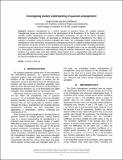Files in this item
Investigating student understanding of quantum entanglement
Item metadata
| dc.contributor.author | Kohnle, Antje | |
| dc.contributor.author | Deffebach, Erica | |
| dc.contributor.editor | Churukian, Alice D. | |
| dc.contributor.editor | Jones, Dyan | |
| dc.contributor.editor | Ding, Lin | |
| dc.date.accessioned | 2016-02-15T12:10:09Z | |
| dc.date.available | 2016-02-15T12:10:09Z | |
| dc.date.issued | 2015-12-18 | |
| dc.identifier | 228485948 | |
| dc.identifier | 1e03929f-282a-400f-8438-f90c5a077b6d | |
| dc.identifier | 000375147300040 | |
| dc.identifier.citation | Kohnle , A & Deffebach , E 2015 , Investigating student understanding of quantum entanglement . in A D Churukian , D Jones & L Ding (eds) , 2015 Physics Education Research Conference proceedings . PER Conference series , American Association of Physics Teachers , pp. 171-174 . https://doi.org/10.1119/perc.2015.pr.038 | en |
| dc.identifier.isbn | 978-1-931024-28-0 | |
| dc.identifier.issn | 1539-9028 | |
| dc.identifier.other | ORCID: /0000-0003-2638-4826/work/27138988 | |
| dc.identifier.uri | https://hdl.handle.net/10023/8226 | |
| dc.description | The authors thank the UK Institute of Physics for funding the simulation development. | en |
| dc.description.abstract | Quantum entanglement is a central concept of quantum theory for multiple particles. Entanglement played an important role in the development of the foundations of the theory and makes possible modern applications in quantum information technology. As part of the QuVis Quantum Mechanics Visualization Project, we developed an interactive simulation Entanglement: The nature of quantum correlations using two-particle entangled spin states. We investigated student understanding of entanglement at the introductory and advanced undergraduate levels by collecting student activity and post-test responses using two versions of the simulation and carrying out a small number of student interviews. Common incorrect ideas found include statements that all entangled states must be maximally entangled (i.e. show perfect correlations or anticorrelations along all common measurement axes), that the spins of particles in a product state must have definite values (cannot be in a superposition state with respect to spin) and difficulty factorizing product states. Outcomes from this work will inform further development of the QuVis Entanglement simulation. | |
| dc.format.extent | 2391478 | |
| dc.language.iso | eng | |
| dc.publisher | American Association of Physics Teachers | |
| dc.relation.ispartof | 2015 Physics Education Research Conference proceedings | en |
| dc.relation.ispartofseries | PER Conference series | en |
| dc.subject | PERC 2015 | en |
| dc.subject | QC Physics | en |
| dc.subject | LB2300 Higher Education | en |
| dc.subject | NDAS | en |
| dc.subject.lcc | QC | en |
| dc.subject.lcc | LB2300 | en |
| dc.title | Investigating student understanding of quantum entanglement | en |
| dc.type | Conference item | en |
| dc.contributor.institution | University of St Andrews. School of Physics and Astronomy | en |
| dc.contributor.institution | University of St Andrews. Centre for Higher Education Research | en |
| dc.identifier.doi | 10.1119/perc.2015.pr.038 |
This item appears in the following Collection(s)
Items in the St Andrews Research Repository are protected by copyright, with all rights reserved, unless otherwise indicated.

